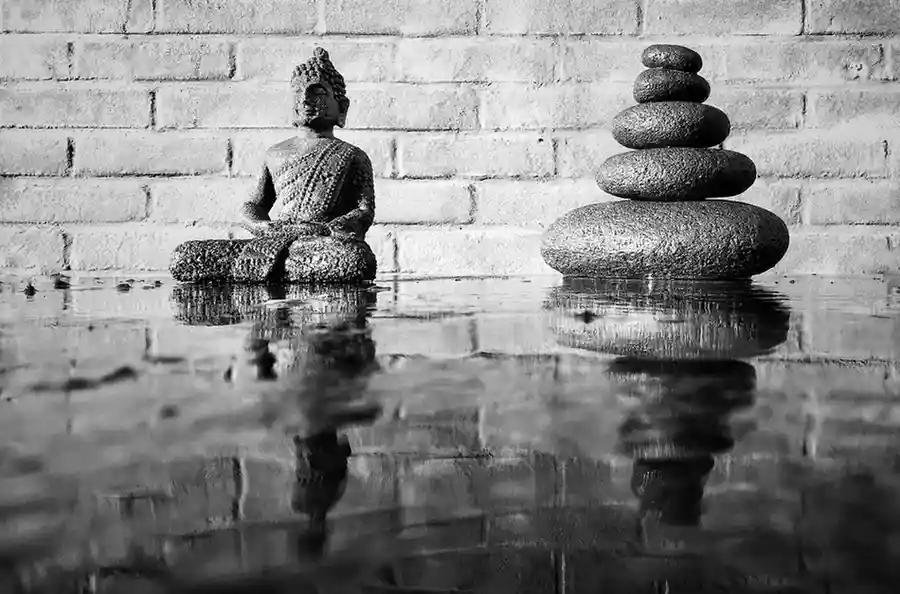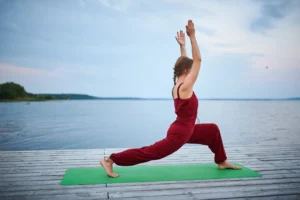Table of Contents
ToggleOur modern lives are filled with constant noise, clutter, and the pressure to consume more. Many of us end up surrounded by things we don’t really need, which can create stress, distraction, and a sense of imbalance. Buddhism and minimalism naturally complement each other in addressing this challenge. By practicing Buddhist minimalism and embracing mindful minimalism, we can focus on what truly matters, reduce unnecessary distractions, and cultivate a life of clarity and purpose.
This blog will explore how a Buddha minimalist lifestyle can help you live with less while gaining more peace, focus, and intentionality. You’ll learn practical tips for applying mindful minimalism in daily life, understand the benefits of simplifying your surroundings, and discover how letting go of excess can lead to greater happiness and spiritual balance.
What Is Minimalism?
Minimalism is a lifestyle that focuses on living with intention, keeping only what truly adds value to your life. It’s about more than just decluttering your home or workspace; it’s about simplifying your surroundings, your schedule, and even your mindset. By embracing Buddhist minimalism and mindful choices, you create space for clarity, purpose, and well-being. Living with less doesn’t mean living with deprivation; it offers freedom from unnecessary distractions and the stress of excess. Through mindful minimalism, individuals can experience greater happiness, focus on meaningful relationships, and cultivate a life aligned with their values.
Minimalism in Buddhist Teachings
Buddhist minimalism naturally emphasizes living with intention and simplicity. At the heart of this approach is the Middle Way, which teaches finding balance and avoiding both excess and extreme self-denial. By practicing non-attachment, individuals learn to let go of unnecessary possessions, habits, and mental clutter, reducing stress and fostering inner peace. Mindfulness, another key principle, helps us stay aware of our choices, encouraging conscious consumption and deliberate living. Together, these teachings show how Buddhism and minimalism connect, guiding us toward a life that values purpose, clarity, and contentment over accumulation.
The Four Noble Truths of Minimalism
Rooted in Buddhist philosophy, the Four Noble Truths offer profound insights into the nature of suffering and the path to liberation. When applied to minimalism, these truths guide us towards a life of simplicity, intentionality, and inner peace.
1. Dukkha (The Truth of Suffering): Recognizing Clutter as Mental Noise
In Buddhism, dukkha refers to the inherent dissatisfaction in life. In the context of minimalism, this translates to the realization that excess possessions and mental clutter contribute to stress and distraction. Acknowledging this suffering is the first step towards embracing a minimalist lifestyle.
2. Samudaya (The Cause of Suffering): Understanding Craving and Attachment
The cause of suffering is identified as tanha, or craving. In minimalism, this manifests as our attachment to material possessions and the constant desire for more. Recognizing these cravings allows us to detach and focus on what truly adds value to our lives.
3. Nirodha (The Cessation of Suffering): Letting Go of Excess
Nirodha signifies the cessation of suffering. By letting go of unnecessary possessions and mental clutter, we create space for peace and clarity. This aligns with the minimalist principle of owning only what is essential and meaningful.
4. Magga (The Path to the Cessation of Suffering): The Eightfold Path of Minimalism
The path to ending suffering is the Magga, or the Eightfold Path. In minimalism, this involves:
- Right Understanding: Recognizing the value of simplicity.
- Right Intent: Choosing intentional living.
- Right Speech: Communicating with clarity and purpose.
- Right Action: Engaging in meaningful activities.
- Right Livelihood: Pursuing work that aligns with values.
- Right Effort: Striving for continuous improvement.
- Right Mindfulness: Being present and aware.
- Right Concentration: Focusing on what matters most.
Benefits of Living with Less: Embracing Buddhist Minimalism
- Mental Clarity and Inner Peace – By reducing clutter and distractions, Buddhist minimalism fosters a calm mind, helping you think clearly and focus on what truly matters.
- Reduced Stress and Anxiety – Mindful minimalism encourages letting go of unnecessary possessions and obligations, which lowers mental strain and promotes emotional well-being.
- Deeper Focus on Relationships and Purpose – Living with less allows you to invest more time and energy in meaningful connections and activities aligned with your values.
- Eco-Friendly and Sustainable Lifestyle – Owning fewer items reduces consumption, minimizes waste, and encourages sustainable choices, reflecting the mindful and compassionate principles of Buddhism.
- Financial Freedom and Simplicity – By buying less and prioritizing needs over wants, you save money, reduce financial stress, and create freedom for experiences rather than material accumulation.
- Enhanced Mindfulness and Presence – Buddhist minimalism teaches awareness in every choice, helping you live intentionally and fully in the present moment.
- Greater Happiness and Contentment – Owning less and valuing experiences over possessions aligns with the Buddhist philosophy of non-attachment, increasing overall satisfaction and joy.
- Support for Personal Growth – Simplifying life frees up mental and emotional space to explore spirituality, creativity, and personal development.
Practical Ways to Combine Buddhism and Minimalism
- Practice Mindful Decluttering – Regularly assess your belongings and let go of items that no longer add value. Buddhist minimalism emphasizes releasing attachment to unnecessary possessions to create a calmer, more intentional living space.
- Gratitude in Daily Life – Be grateful for what you already have. Mindful minimalism is about noticing what you have, not always trying to get more.
- Choose Mindful Consumption – Before buying, consider whether the item serves a purpose or aligns with your values. Buddhist minimalism promotes conscious purchasing to reduce clutter and environmental impact.
- Create a Calm Meditation Space – Dedicate a serene corner for meditation, reflection, or mindful breathing. This encourages mental clarity and reinforces the principles of Buddhist minimalism.
- Focus on Experiences, Not Possessions – Invest in meaningful experiences, relationships, and personal growth instead of material items.
- Simplify Digital Spaces – Turn off unnecessary notifications, unsubscribe from emails you don’t need, and clear out your digital devices to stay more mindful online.
- Adopt a Capsule Wardrobe – Keep only essential clothing items that you love and use regularly, supporting both minimalist and mindful living.
- Limit Multitasking – Focus on one activity at a time to reduce mental clutter and enhance mindfulness.
- Practice Intentional Giving – Donate or gift items you no longer need, fostering generosity while maintaining a minimalist environment.
Common Misunderstandings About Buddhist Minimalism
- Minimalism is not poverty -Living a minimalist lifestyle doesn’t mean giving up what you need. It means living on purpose, using things mindfully, and cutting out unnecessary stuff, without feeling deprived.
- Buddhism does not mean rejecting everything – Buddhist minimalism encourages non-attachment and simplicity, but it does not require giving up everything you own. It’s about valuing what truly matters.
- Owning less can still mean living joyfully – True happiness comes from mindfulness, purpose, and experiences, rather than material possessions. Less clutter often leads to greater mental clarity and inner peace.
- Minimalism is a mindset, not just decluttering – It’s about conscious choices in all areas of life, including work, relationships, and spending habits.
- Mindful consumption is key – Choosing quality over quantity, eco-friendly products, and purposeful spending aligns with both minimalism and Buddhist values.
- Simplifying life enhances focus and well-being – Reducing distractions allows more time for personal growth, spiritual practices, and meaningful connections.
- Minimalism and spirituality go hand in hand – Buddhist minimalism integrates mindfulness, non-attachment, and ethical living to support mental clarity, compassion, and a purposeful lifestyle.
Living with Purpose Through Minimalism
- Align Daily Choices with Your Values – Make intentional decisions about what you keep, buy, or prioritize. This reflects the core of Buddhism and minimalism, where mindful choices create harmony and reduce unnecessary distractions.
- Find Freedom Through Simplicity – Letting go of excess belongings and mental clutter allows space for personal growth, peace, and focus on what truly matters, reflecting the Buddha’s minimalist approach.
- Build Compassion and Awareness – Minimalist living encourages empathy, mindfulness, and deeper awareness of yourself and others, aligning with principles of mindful minimalism.
- Focus on Experiences, Not Possessions – Prioritize meaningful activities, relationships, and learning over accumulating material goods, enhancing joy and life satisfaction.
- Practice Mindful Consumption – Make conscious choices when acquiring new items, ensuring they serve a purpose and add value, reducing waste and unnecessary clutter.
- Simplify Your Environment – Create spaces that are calming, functional, and free of distractions, which promotes mental clarity and reduces stress.
- Cultivate Gratitude – Appreciating what you already have strengthens contentment and reduces the urge for constant acquisition.
- Integrate Daily Mindfulness Practices – Meditation, journaling, or mindful reflection can reinforce minimalist habits and connect you with inner peace.
- Set Intentional Boundaries – Limit commitments, social media, and other distractions that do not align with your values or goals.
Real-Life Inspirations: Living Buddhist Minimalism
The principles of Buddhism and minimalism are not just theoretical; they are practiced by people across different walks of life. From monasteries to modern homes, Buddhist minimalism shows how living simply can bring clarity, purpose, and peace. Buddhist monks practice mindful minimalism by keeping only what they need and spending their days on meditation, learning, and helping others. Similarly, minimalist homes designed with intention create serene spaces that encourage reflection and focus, blending practicality with calm aesthetics. Even ordinary individuals are embracing a Buddha minimalist lifestyle, curating their possessions, choosing mindful consumption, and prioritizing experiences over material things. These examples demonstrate how adopting mindful and intentional simplicity can improve mental well-being, foster spiritual growth, and cultivate a meaningful, purposeful life.
Conclusion
Buddhism and minimalism together offer a meaningful path to simplify life, reduce stress, and live intentionally. By carefully clearing out unnecessary things, non-attachment, and gratitude, you can cultivate inner peace, focus on experiences over possessions, and align daily actions with your values. Start small today with one mindful change and gradually build a balanced, purposeful lifestyle. For more insightful blogs on mindfulness, minimalism, and intentional living, visit Hidden Mantra.
FAQ
Is minimalism the same as Buddhism?
While minimalism and Buddhism share similarities in valuing simplicity, they are distinct concepts. Buddhism is a spiritual tradition focused on the path to enlightenment, emphasizing practices like meditation, mindfulness, and ethical living. Minimalism, on the other hand, is a lifestyle choice that involves reducing material possessions to focus on what truly matters. Both advocate for detachment from excess, but Buddhism encompasses a broader spiritual framework, whereas minimalism is primarily concerned with material and mental decluttering.
What is the difference between minimalism and frugality?
Minimalism is about intentional living, focusing on quality over quantity, and eliminating distractions to prioritize meaningful experiences. Frugality, however, centers on saving money and reducing expenses, often through cost-cutting measures. While both approaches can lead to financial savings, minimalism emphasizes a holistic approach to life, whereas frugality is more financially driven.
Does minimalism really make you happier?
Yes, many individuals report increased happiness through minimalism. By reducing physical and mental clutter, minimalism allows for more time and energy to focus on personal growth, relationships, and experiences. This shift often leads to a greater sense of fulfillment and contentment.
How does mindfulness support minimalism?
Mindfulness enhances minimalism by fostering awareness of the present moment, helping individuals make intentional choices about what to keep and what to let go. This practice encourages non-judgmental observation, aiding in the decision-making process and promoting a minimalist mindset.
Can minimalism reduce stress and anxiety?
Adopting a minimalist lifestyle can significantly reduce stress and anxiety. By decluttering physical spaces and simplifying routines, individuals often experience less overwhelm and greater mental clarity. This simplification can lead to improved emotional well-being and a more peaceful state of mind.









